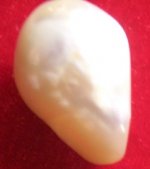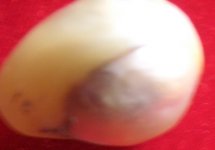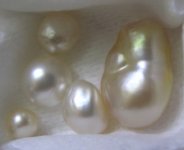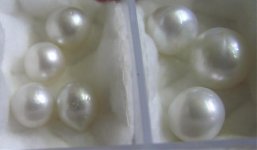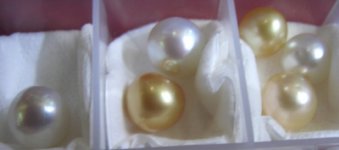You are using an out of date browser. It may not display this or other websites correctly.
You should upgrade or use an alternative browser.
You should upgrade or use an alternative browser.
Tom Stern's natural pearls
- Thread starter DrTKStern
- Start date
Caitlin
Well-known member
This view is why Tom did not like it. It is a thick layer of translucent matter, maybe it is almost pure conchilion. but when you move it as you look into it- deep inside it reflects back a similar- iridescent pattern as the first big one above.
Attachments
Caitlin
Well-known member
Caitlin
Well-known member
Caitlin
Well-known member
Caitlin
Well-known member
Oh my god, those are so beautiful! Are natural pearls from P. maxima still being found? Or are those (in the pictures) very old? And how large are they? I've never seen any natural pearls in person before, and I love seeing and hearing about them here. I hope one day to own a single beautiful natural pearl.
Nicole
Nicole
SteveM
Well-known member
- Joined
- Jan 29, 2007
- Messages
- 2,113
As in anything, the key to understanding is frequent and intense exposure. Thanks to Caitlin for posting the pictures for the benefit of everyone here.
Comment from my natural-pearl friends in the South Seas was that neither pearl in my last post had orient, also that the photo of Tom's pearl did appear to have an incomplete nacre layer. Substitution of pure, translucent conchiolin for aragonite, however rare and potentially beautiful, would seem consistent with this. So still a bit of a head scratcher?
Comment from my natural-pearl friends in the South Seas was that neither pearl in my last post had orient, also that the photo of Tom's pearl did appear to have an incomplete nacre layer. Substitution of pure, translucent conchiolin for aragonite, however rare and potentially beautiful, would seem consistent with this. So still a bit of a head scratcher?
(1) Thanks Caitlin for posting those beautiful photos of the pearls. It is interesting you mentioned the translucent layer that as you move deep inside it reflects back an iridescent pattern. I have a tiny but high quality opal, when you rotate and view from the side you can see red iridescence from deep within a dark body too. May be the deep iridescence in both pearls and opals share the same phenomena?
It is interesting you mentioned the translucent layer that as you move deep inside it reflects back an iridescent pattern. I have a tiny but high quality opal, when you rotate and view from the side you can see red iridescence from deep within a dark body too. May be the deep iridescence in both pearls and opals share the same phenomena?
(2) I have a question about GIA certificates of those pearls. Is the purpose of the certificates to prove/show that they are natural, marine pearls? How old are those certificates? Would newer GIA certificates (assuming newer technologies) be more reliable? I believe those pearls are naturals or keishis but just curious about the GIA certification process.
Thanks again,
Pernula
(2) I have a question about GIA certificates of those pearls. Is the purpose of the certificates to prove/show that they are natural, marine pearls? How old are those certificates? Would newer GIA certificates (assuming newer technologies) be more reliable? I believe those pearls are naturals or keishis but just curious about the GIA certification process.
Thanks again,
Pernula
Caitlin
Well-known member
There is a story behind those pearls. My version is incomplete and may be full of errors, but this is what I remember.
Tom is a surgeon who has long done humanitarian projects. Partly because of his marriage to Yolanda, partly because of his humanitarian projects, he has gained the trust and support of the Sultan of Borneo (and some related islands), who adopted him.
Now Tom is collecting pearls from the area. He put out a call for natural pearls in the last year or so. He then had the pearls which were brought to him certified by the GIA. There was a fairly high percent (maybe 30%?) that were cultured pearls and the certifications revealed which were which. Then on his second call for pearls, the percent has gone up to 85% naturals.
He is having each one tested because of the fudge factor. Some of these pearls are old. Some may be newer. I do not know how he came by the keshis, but they are huge. I think that a relatively untouched, pearl-rich area is disgorging pearls that lost their market 100 years ago. Tom's interest has single handedly encouraged people to bring out their long held treasures and kindled their hopes to get good prices for them.
He is taking his time selling them and really wants to learn the market first.
Apparently Jewelmer or some one like that has the area locked up for the cultured pearl industry and these are the same waters, more or less, where the SSP's coming from the areas around the Philippines are grown.
Tom is a surgeon who has long done humanitarian projects. Partly because of his marriage to Yolanda, partly because of his humanitarian projects, he has gained the trust and support of the Sultan of Borneo (and some related islands), who adopted him.
Now Tom is collecting pearls from the area. He put out a call for natural pearls in the last year or so. He then had the pearls which were brought to him certified by the GIA. There was a fairly high percent (maybe 30%?) that were cultured pearls and the certifications revealed which were which. Then on his second call for pearls, the percent has gone up to 85% naturals.
He is having each one tested because of the fudge factor. Some of these pearls are old. Some may be newer. I do not know how he came by the keshis, but they are huge. I think that a relatively untouched, pearl-rich area is disgorging pearls that lost their market 100 years ago. Tom's interest has single handedly encouraged people to bring out their long held treasures and kindled their hopes to get good prices for them.
He is taking his time selling them and really wants to learn the market first.
Apparently Jewelmer or some one like that has the area locked up for the cultured pearl industry and these are the same waters, more or less, where the SSP's coming from the areas around the Philippines are grown.
Caitlin
Well-known member
Hi Steve
I have been trying to figure out what gives with these pearls. The picture I put up is enlarged, so it shows a little more of the structures of the pearl. The iridescence tends to go in diagonal lines and planes in the baroques and the ones with water. When you move the pearl in the light, different sheets/layers can be seen depending on the angle.
The material I described as being like horn, still feels like a mineral, not horn. I think the odd shaped pearls let you see through the edges, so you can see how "water" works.
In a round pearl with water, there would be an interplay between the different layers of aragonite in the conchilion. so it would glow around the edges, but depending on the view, you can see the sheets of aragonite in the structure of the pearl all the way to the edge. The aragonite is in there, it just seems to do a different dance with the conchilion
This creates a different effect than when the surface layers of the pearl are where the interplay takes place, which is what we are used to.
Can you please tell me what I am trying to say?
I have been trying to figure out what gives with these pearls. The picture I put up is enlarged, so it shows a little more of the structures of the pearl. The iridescence tends to go in diagonal lines and planes in the baroques and the ones with water. When you move the pearl in the light, different sheets/layers can be seen depending on the angle.
The material I described as being like horn, still feels like a mineral, not horn. I think the odd shaped pearls let you see through the edges, so you can see how "water" works.
In a round pearl with water, there would be an interplay between the different layers of aragonite in the conchilion. so it would glow around the edges, but depending on the view, you can see the sheets of aragonite in the structure of the pearl all the way to the edge. The aragonite is in there, it just seems to do a different dance with the conchilion
This creates a different effect than when the surface layers of the pearl are where the interplay takes place, which is what we are used to.
Can you please tell me what I am trying to say?
SteveM
Well-known member
- Joined
- Jan 29, 2007
- Messages
- 2,113
Perhaps the Garuda Paruna (Nova Moti) remains the ultimate authority. Regarding the physics, opals do seem to present a possible analogy, ie iridescent matter that is suspended within a matrix.I have been trying to figure out what gives with these pearls?Can you please tell me what I am trying to say?
I am saddened not to join you all at Janos' following the Pearl Walk on Saturday, as conversation should be lively! (Janos has been an occasional wine client of ours over the years).
Steve
V
Valeria101
Guest
pernula said:... May be the deep iridescence in both pearls and opals share the same phenomena?
I think so - rainbow colors produced by interference caused by the structure of the pearl or that of opal: the materials are very different, but both form microscopic 'grids' that play with light
There is a thread somewhere on this forum called "Iridescence" about this... All sorts of materials sometimes yield iridescence: iridescent topaz anyone (LINK)?
DrTKStern
Natural Pearl Connoisseur
(1) Thanks Caitlin for posting those beautiful photos of the pearls.It is interesting you mentioned the translucent layer that as you move deep inside it reflects back an iridescent pattern. I have a tiny but high quality opal, when you rotate and view from the side you can see red iridescence from deep within a dark body too. May be the deep iridescence in both pearls and opals share the same phenomena?
(2) I have a question about GIA certificates of those pearls. Is the purpose of the certificates to prove/show that they are natural, marine pearls? How old are those certificates? Would newer GIA certificates (assuming newer technologies) be more reliable? I believe those pearls are naturals or keishis but just curious about the GIA certification process.
Thanks again,
Pernula
Hello,
The pearls are almost entirely coming from the Sarawak area, not from where Jewelmer has its pearl farms. All GIA reports are from the last few months. I do not believe ANYONE can distinguish a natural pearl reliably without testing, particularly when a natural is so big, round, and lustrous that the viewer assumes it must be cultured.
Wish I could have stayed in Tucson for Caitlin's Pearl Walk to chat with all of you experts.
Tom
DrTKStern
Natural Pearl Connoisseur
West African Pearls
West African Pearls
I just returned from a conference in Dakar, Senegal. While there, someone tried to sell me what they claimed was a natural ocean pearl; but I had no time to have testing done. In Dakar, people eat a lot of fresh oysters. Has anyone ever seen a natural ocean pearl from West Africa?
West African Pearls
I just returned from a conference in Dakar, Senegal. While there, someone tried to sell me what they claimed was a natural ocean pearl; but I had no time to have testing done. In Dakar, people eat a lot of fresh oysters. Has anyone ever seen a natural ocean pearl from West Africa?
V
Valeria101
Guest
DrTKStern said:Has anyone ever seen a natural ocean pearl from West Africa?
Any news on your side?
Even the record of marine pearl-suspect species is sketchy for the region. Aside diamonds, I can't remember what was the last bit of gemology news from the western African coast down to Angola....
Last edited by a moderator:
DrTKStern
Natural Pearl Connoisseur
Any news on your side?
Even the record of marine pearl-suspect species is sketchy for the region. Aside diamonds, I can't remember what was the last bit of gemology news from the western African coast down to Angola....
Big find of diamonds in Mauritania. Nothing new on West African pearls, if any exist. Will be returning before long, and will spend some time looking for naturals.
Thanks,
Tom
Mikeyy
Pearl Diver
I was wondering what a diver gets for one of these pearls he finds. And also when shell prices in the U.S. went up there was a rush of new divers that joined in and caused some over fishing. So I was curious. What do you do to protect the shell populations from the mad drive to find pearls.
DrTKStern
Natural Pearl Connoisseur
I was wondering what a diver gets for one of these pearls he finds. And also when shell prices in the U.S. went up there was a rush of new divers that joined in and caused some over fishing. So I was curious. What do you do to protect the shell populations from the mad drive to find pearls.
Hi, Mike, There really isn't any mad rush, because the water is too deep for anyone who has not been going down most of their lives, so there is no depletion going on. I pay them a lot of money, depending on quality. Tom
J
jerin
Guest
It's nice that someone other than me ask this type of question. I fear sounding like a broken record when I bring these things up.
I am not sure I am satisfied with the answer though.
Slraep
No, we want size, cost and worth of a certain natural
Inge
Similar threads
- Replies
- 99
- Views
- 17K
- Replies
- 3
- Views
- 3K

